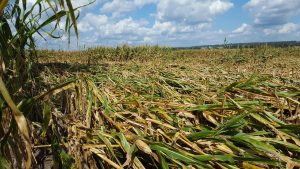 Recent rains have caused flooding and ponding in many cornfields. Growers are concerned about corn growth and development and any yield effects that might occur from short periods of flooding. Many crop fields were completely destroyed, while others were left with varying degrees of damage. Before making any decisions about your fields, you should document and report any crop damage to your local U.S. Department of Agriculture Farm Service Agency (USDA FSA) office, your crop insurance agent and the Wisconsin Department of Agriculture, Trade and Consumer Protection You are strongly encouraged to take ‘time-dated’ photos of any damage. Such information may be critical in federal emergency determinations and your eligibility for these programs.
Recent rains have caused flooding and ponding in many cornfields. Growers are concerned about corn growth and development and any yield effects that might occur from short periods of flooding. Many crop fields were completely destroyed, while others were left with varying degrees of damage. Before making any decisions about your fields, you should document and report any crop damage to your local U.S. Department of Agriculture Farm Service Agency (USDA FSA) office, your crop insurance agent and the Wisconsin Department of Agriculture, Trade and Consumer Protection You are strongly encouraged to take ‘time-dated’ photos of any damage. Such information may be critical in federal emergency determinations and your eligibility for these programs.
The extent to which flooding injures corn is determined by several factors including: 1) timing of flooding during the life cycle of corn, 2) frequency and duration of flooding, and 3) air-soil temperatures during flooding (Belford et al., 1985).
Flooding at any time when the growing point is below the water level can kill the corn plant in a few days, especially if temperatures are high. Growing point tissues are depleted of oxygen. After a storm event we need to be patient and let plants respond. Plants can usually survive short periods of flooding of less than 48 hours (Wenkert et al., 1981).
Source: Joe Lauer, Ph.D, Professor, Extension Corn Specialist, UW Madison Agronomy Department.



